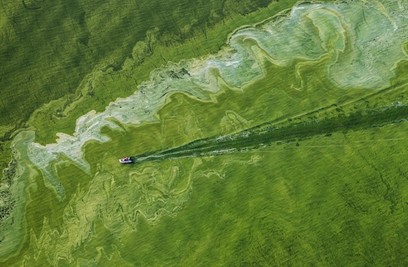By Anna Cotterman, Farm Seasonal
As the media continues to discuss climate change and the environmental issues related to it, it is hard to keep track of some of the big issues. Frequently there are terms or concepts thrown about with no explanation. Here are some of the big issues in Ohio!
Climate Change vs Global Warming
To start to understand climate change and global warming, it is important to make the distinction between weather and climate. Weather is what is currently outside your window, whereas climate is the overall averages of weather. Global warming is the fact that the climate (or the average) is warming, this means that there are still cold days even with global warming. Global warming is simply one aspect of climate change. Other effects are more intense weather events overall such as colder winters, more intense rainfall events, more wildfires, and longer harsher droughts.
Greenhouse Gases
Greenhouse gases are all the gases in the Earth’s atmosphere. However, when discussed in the climate change discussion, they do not mean all gases. A popular thought is that carbon dioxide is the only bad guy in climate change, but there are other gases present causing damage. One large contributor is methane gas. This comes from burning fossil fuels, such as gas from your car or burning coal for electricity. It is also released through the breakdown of food and other waste in landfills. Not only do these gases trap heat in the atmosphere, they also reduce air quality of the air your breathe.
 Carbon Sequestration and Carbon Banks
Carbon Sequestration and Carbon Banks
The goal to reduce carbon in the atmosphere means we need somewhere to store carbon, but how do you store a molecule? The answer is actually all around us. Carbon is stored in trees, soils, and other plants. This carbon storage is what is referred to as carbon sequestration. With this in mind, how we manage our natural resources has become increasingly important. A carbon bank is somewhere that can hold carbon and is designated for the sequestration of carbon. Recently payback programs have been discussed to pay farmers and landowners to utilize their land as carbon banks. Farmers will be paid per ton of carbon stored while using regenerative agricultural practices to help store carbon in the soil. This includes no-till, conservation tillage, and cover cropping. These are all methods that we are utilizing here at Gallant Farm.
Nutrient Runoff and Algae Blooms
With summer approaching there is one thing on everyone’s mind, the algae blooms in Lake Erie. The algae in these blooms can be both toxic for you and toxic for the environment. They are cyanobacteria blooms. These blooms form when there is an excess of nutrients such as nitrogen and phosphorous in water systems. They get into these systems through runoff. Nutrient runoff is when nutrients, such as fertilizers, are applied to surfaces. Rain events then occur and the fertilizer, that has yet to be consumed by the plants, is washed away into the local water systems. As discussed earlier, with climate change weather events are becoming more frequent and more powerful. This means that rain events are creating greater runoff from an increase in rainfall and longevity of rain events. Another important factor in the growth of these algae blooms is the temperature of the water. As temperatures rise globally, the lake water also heats up and retains the heat for longer. The warm water plus excess nutrient runoff are large contributing factors to the blooms in the lake. These blooms do not occur just in Lake Erie. There are blooms popping up all over Ohio. Do not fear, not all blooms are harmful to you and your pets. Just make sure to check postings before you swim.






